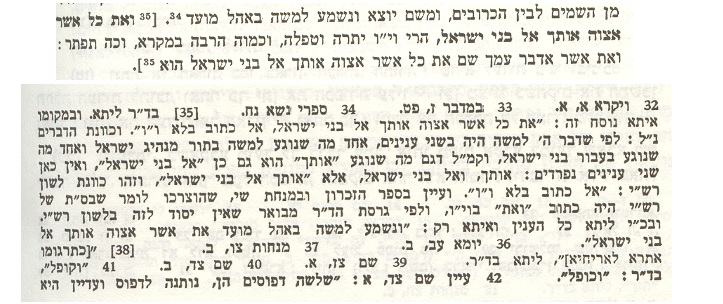On today’s page of Talmud there is a fairly bland discussion about how many people are called to the Torah on various days. Here is an excerpt from a discussion about the seven people who are called on Shabbat. Read it carefully.
מגילה כב, א
אִיבַּעְיָא לְהוּ: מַפְטִיר, מַהוּ שֶׁיַּעֲלֶה לַמִּנְיָן שִׁבְעָה? רַב הוּנָא וְרַבִּי יִרְמְיָה בַּר אַבָּא, חַד אָמַר: עוֹלֶה, וְחַד אָמַר: אֵינוֹ עוֹלֶה
A dilemma was raised before the Sages: With regard to the reader who concludes [maftir] the Torah reading and reads from the Prophets [haftorah], what is the halakha; does he count toward the quorum of seven readers? Rav Huna and Rabbi Yirmeya bar Abba disagreed about this matter. One said: He counts, and one said: He does not count.
Ok, so according Rav Huna and Rabbi Yirmeya bar Abba disagree about how to count the person called to read the haftorah. Not a big deal really. And as most readers will know, our custom today is that we call seven people to the read from the Torah on Shabbat, and an eighth person is called to read the haftorah. This is also the way the halakha is codified in the Shulkhan Arukh.
אורח חיים רפ״ב:ד׳
נוהגים לקרות שבעה לגמור עמהם הפרשה ואומר קדיש וחוזר וקורא עם המפטיר מה שקרא השביעי. הגה וכן נוהגים בימים טובים שאין מפטיר ממנין הקרואים אבל בחול שאסור להוסיף על מנין הקרואים השלישי הוא מפטיר וביום שמוציאין ב' ספרים או ג' המפטיר קורא באחרונה וקטן יכול לקרות בפרשת המוספין או בד' פרשיות שמוסיפין באדר וכן נוהגים (ר"ן ומרדכי פ"ב דמגילה) אע"פ שיש חולקים ואומרים קדיש קודם שעולה המפטיר ואין חילוק בזה בין הוסיפו על מנין הקרואים או לא ובין מוציאין ס"ת א' או ג' (ב"י בשם הר"ר ישעיה והרא"ש ורבי ירוחם)
It is customary to read 7 (aliyot) to complete the parshah. We then say Kaddish, and then go back and the maftir reads what the seventh person read. RAMA: It is our custom on Yom Tov that the maftir is not from the amount of the readers. However, during the week, when it is forbidden to add to the amount of readers, the third one is the maftir. On a day where two or three Torahs are taken out, the maftir reads the last one. And a minor may read the additional parshah, or from the four parshiyot that are added in Adar, and this is our custom (R"an; Mordechai), even though there are those who disagree. And we say kaddish prior to the maftir being called up, there is no difference in this regarding adding to the amount of (aliyos) or not, or regarding taking out two or three Torahs (Beis Yosef in the name of R' Yeshayah; the Rosh; R' Yerucham).
The Dispute over the count on Shabbat Chatan
This area of Jewish law engendered a terrible dispute in the eighteenth century. It centered on the custom among Sephardic Jews of reading a special, additional Torah portion on the Sabbath after a wedding; the groom would be called to the Torah as the portion was chanted, but the precise status of this reading was not clear. Should it count as one of the standard seven portions that are read each week on the Sabbath, or should it be considered an additional, eighth reading? This turned out to be a surprisingly contentious question among the Italian rabbis of the eighteenth century.
In 1735 in Pisa, Rabbi Eliezer Supino ruled that the groom should be called up as one of the standard seven to read from the Torah, but this position was opposed by David ben Abraham Meldola and his cousin Rabbi Raphael Meldola. The Meldolas argued that the weekly Torah portion would be read as usual in seven parts, and that the groom would then be called to read as an eighth person. The dispute continued for almost a decade and involved the rabbinic leaders of several other communities, including Amsterdam, Tunis, and Algeria. In 1738, Supino published his reasoning in a small pamphlet called Kuntres Al Inyan Shabbat Hahatunnah (A Treatise Concerning the Sabbath Wedding,) but although it was printed in Amsterdam, the work was never released for sale to the public. Supino printed three hundred copies of his work but it remained in the Amsterdam printer’s warehouse for over two years, apparently as a result of a financial dispute between Supino and the publisher.
The Meldolas heard of the existence of the pamphlet and after exerting pressure on the publisher, seized and burned all but a single copy, which was saved from destruction and is now shelved in the library of the Jewish Theological Seminary in Jerusalem.
First page of the Responsa by Rabbi Eliezer Supino. It is the only known copy. All the others were burned by the publisher.
David Meldola, the son of Raphael was just twenty-one years old at the time of the incident that began the whole affair, and it was he who was sent by his father Raphael to locate and destroy the pamphlet by Supino. This early involvement at an impressionable age may explain why David Meldola remained obsessed with the affair: Seventeen years after the original episode (and after the deaths of Rabbi Supino and both Rabbis Meldola), David Meldola published a book of responsa that contained no fewer than eighteen chapters over sixty-one pages describing the affair and its resolution.
The argument between the Meldolas and Rabbi Supino largely revolved around the weight that should be placed on local customs, and the dramatic way in which the Meldolas destroyed Rabbi Supino’s work should be a chilling reminder of the power that these customs sometimes have over us.








